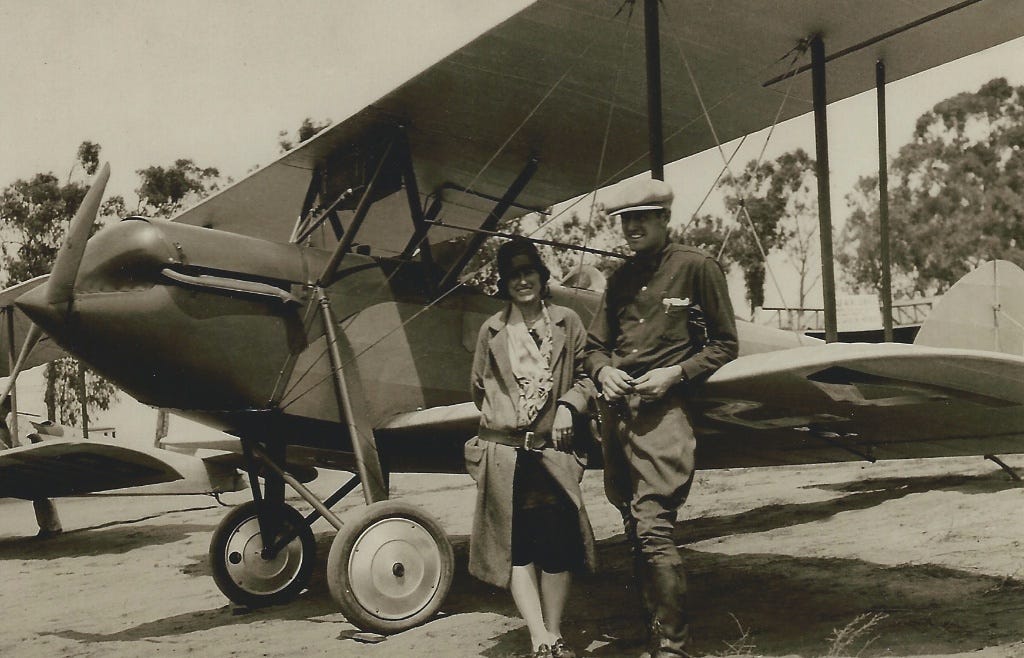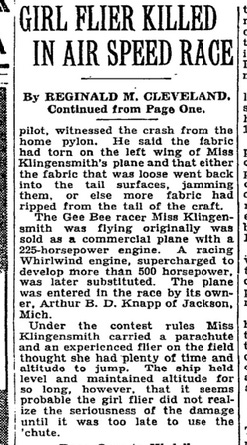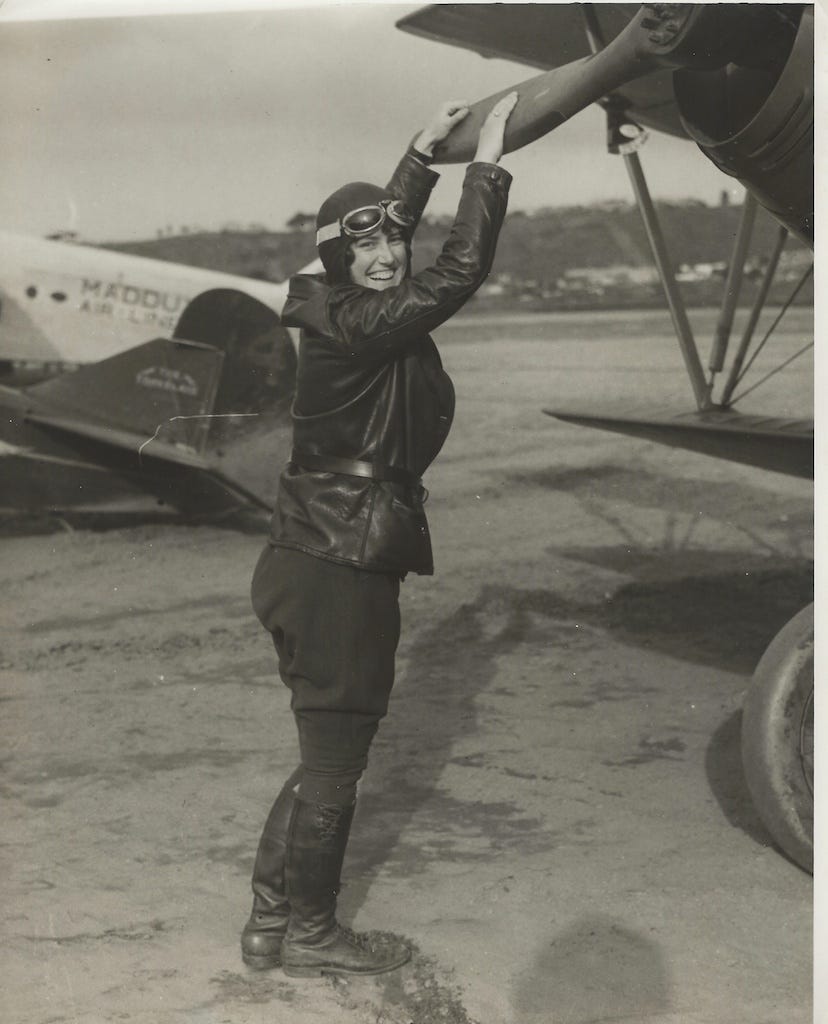Let’s get serious about the reason why there are so few women in aviation.
This is Marvel Crosson, with her brother Joe, a legendary Alaskan pilot. I’m mildly obsessed with Marvel and have written about her before, both on substack and for the Anchorage Daily News. A quick recap of her career: in California she and Joe rebuilt from scrap the airplane they learned to fly in, she was the first licensed female pilot in Alaska1, she flew some commercial flights there, she set an altitude record when back in California, and in 1929 she was a favorite in the first Women’s Air Derby before she died in an unexplained crash in Arizona.
Marvel Crosson was awesome and I wish she was as famous as she deserves to be.
When I researched her for the 2016 ADN profile, I found a Marvel reference in comments from Dr. Louis Hopewell Bauer, the founder of U.S. aviation medicine. Bauer, who became the editor of the Journal of Aviation Medicine, (now called the Aerospace Medicine and Human Performance Journal), and was the first federal aviation medical examiner, asserted in 1930 that Marvel’s period was what caused her to crash. One of his comments:
“We found after the air races a year ago that in connection with one of the women who was killed it happened during her menstrual cycle. Unquestionably that had a strong bearing on her accident.”
I didn’t have the word count to get into this for the ADN profile, so I set Bauer aside and didn’t mention him until I devoted a newsletter to Marvel last year. But I was still bothered by how far Bauer’s comments might have gone in derailing women in commercial aviation. So, I spent a bit of time earlier this year looking for the essay where Bauer’s comments surfaced in the late ‘90s and was able to get a copy of it emailed to me.2 The essay’s author, Melodie Andrews, provided excellent source notes in her essay and got me to the original quote and also, well, made it clear that the situation was a lot worse than just a single mention from Dr. Bauer. As it turns out, Marvel’s death was used as an opportunity to demolish women’s advancement in commercial aviation.
First, we don’t know why Marvel Crosson crashed
There was no formal investigation of most plane crashes in 1929. Aviation came under the Department of Commerce and it was one of their inspectors who traveled to Arizona to inspect the wreckage of Marvel’s Travel Air Speedwing Chaparral. His name was J.G. Noel and I’ve had no luck finding out anything substantial about him, including if he was even a pilot.3 Noel’s published comments in various newspapers, which is all we have to go by now, don’t tell us much.
Before Noel got there, others had been all over the wreckage. The local Yuma press reported that he said the plane was “too broken to draw a definite conclusion.” No one from the Curtiss-Wright Company went to Arizona to look at, including Walter Beech who provided the airplane only one month earlier. Joe Crosson, who flew it with her out to California from Wichita a month earlier, reported engine trouble but Beech later told4 the NY Times that while a new engine was sent to Santa Monica in time, it was not put on the plane. The company later clarified his remarks:
Officials of the Wright Aeronautical Corporation said today that the engine of Miss Crosson's plane had been completely overhauled before the air derby began.
President Walter Beech of the Traveler Company. manufacturers of the lane, had said at Wichita that Miss Crosson had had trouble with her engine on the way to the coast and that another had been sent her but was not installed, according to The Associated Press. The Wright officials said that instead of substituting engines, parts from the new one had been used to replace worn parts in the old and that the rebuilt motor had passed all tests before the derby began.
After the accident, the San Diego Union reported that following the first leg out of Santa Monica, Marvel complained about the engine overheating and low oil pressure to the president of the Women’s Aeronautical Association of CA. Whether not Noel knew any of this is unknown. It appears to have no bearing on his findings however, nor did the multiple reports of sabotage against aircraft in the race, which were heavily documented during the competition5.
We know for sure that Marvel had her parachute on and, as her body was found several hundred feet from the aircraft, she did bail out but the chute did not fully deploy. We know she vomited over the side of the aircraft. Noel suggested she waited too long to bail out and that she became “suddenly ill” in the heat and lost control. However, another competitor Louise Thaden, the eventual winner, suffered carbon monoxide poisoning in her Travel Air when she left Wichita for the starting line; it necessitated a landing in Texas and repairs there. Several reporters and others later questioned if Marvel might also have been poisoned in a similar manner but Noel, apparently, shrugged the possibility aside. The easiest thing, always the easiest thing, was to suggest pilot error so that is what he did. And then came Bauer.
The goal was to push women out of aviation
In the September 1930 issue of the Journal of Aviation Medicine, Bauer made a crushing assessment about female pilots:
“under no circumstances should they [women] fly during, immediately before, or immediately after their menstrual period. There is no question but what a woman is more unstable at that time than at other times.”
No one talked about possible problems with Marvel’s aircraft anymore; for the aviation establishment, the story had firmly shifted to the gender of the pilot flying it.
Also in 1930, the organizers of the second Women’s Air Derby insisted only small, slower aircraft could enter. There were also other changes, which did not extend to the men’s races. Understandably, five entrants, including Amelia Earhart, pulled out. She served as the group’s spokesperson and here’s a bit of her statement:
Miss Earhart explained that the women have outgrown the small craft used in last year's race and take great pride in their ability to perform to higher standards of piloting ability. The women also objected to the addition to the flying personnel with the race of two army pilots and a flight surgeon who will accompany the planes on their flights East. This addition is admirable from a safety standpoint, they pointed out, but is not welcome among women competitors unless similar precautions are taken with the men's races.
The Women’s Air Derby was no longer being treated as a true race, but a tightly controlled event rapidly on its way to being little more than a carnival. Then, in 1934, women were banned from all National Air Races by the National Aeronautical Association. That same year, Dr. R.E. Whitehead, Medical Director of the Bureau of Air Commerce, picked up where Bauer had left off, declaring in the Journal of Aviation Medicine:
“It has come to the attention of the Aeronautics Branch that within the last six months there have been a number of serious and fatal accidents among women pilots…and it has been found that they were in their menstrual period.”
The accidents he used in support of this assertion included Florence Klingensmith’s, which involved a purposefully overpowered Gee Bee racer6 that started coming apart in the air prior to crashing. From the NY Times, September 5, 1933:
There was, of course, never any suggestion that when men crashed their gender or biology was the reason.
By 1935 a recommendation was added to the aviation medicine establishment, then adopted by the Civil Aeronautics Administration, that “All women should be cautioned that it is dangerous for them to fly prior to three days after the menstrual period. Many women pilots have fainted when flying during this period with fatal results.” This recommendation effectively grounded women for nearly half of each month. They could not get commercial aviation jobs; prospects for them in the field of aviation were over.
Despite the hiring of Helen Richey, over eight male pilots, for a job with Central Airlines in 19347, despite the success of female pilots during World War II as members of the Women Airforce Service Pilots program, despite the success in testing of the Mercury 13, and the achievements of women like Evelyn Bryan Johnson who earned a staggering 57,6358(!!!!!) hours over the course of her career as a flight instructor, the first female commercial pilot in the airlines did not get hired until 1973.
Let that sink in for a minute. Marvel Crosson died in 1929 and it took nearly 45 years for the airlines to get over the lie that her period made it happen.
I’m going to be angry about this forever
There is a reason why there are so few female commercial pilots. They were actively, consciously, and with great prejudice, kept out of the industry for decades even though the early male and female pilots were very nearly indistinguishable. They all set records, they flew cross country and across oceans, they all accomplished great things. And then, when the aviation industry began to take off, there was a concerted effort to manipulate accident data and lie about why certain crashes occurred. Women were forced out and kept out by a bunch of stupid men. (Yeah, they were stupid.) And the longer they were kept out, the easier it became to say that they didn’t want to be there, or that they weren’t good enough to make aviation a career. The real reason is just too basic to believe: too many powerful men didn’t want them there.
Or even worse, women flying airplanes threatened them and so they had to be stopped.
Here’s another picture of Marvel Crosson. Be angry with me about how some men sought to diminish her greatness by lying about her death and how they diminished all women by not taking the time to figure out what in the world went wrong with her airplane.
And, for the love of all that we hold holy, let’s stop denying that female biology has been used to hold women back. We need more women in aviation because they belong there and always have. Just imagine how many great pilots lost their chance in commercial aviation because they were women. This is an ugly part of the industry’s history (and not the only discrimination we need to talk about). It’s not something to move past but something we must study, acknowledge, and work to fix by doing all we can to get more women to fly professionally.
She was probably the first female pilot in Alaska, but trying to prove that is exhausting and, in my opinion, impossible. (Another woman might have flown solo somewhere in AK before Marvel and just not gotten news coverage.)
The email was from Professor Dan Giedeman of Grand Valley State University in Michigan. Giedeman is the Associate Editor of Essays in Economic and Business History where “Daredevils and Ladybirds: Gender and the Aviation Industry Before World War II” was published in 1995.
According to some reports, Noel was accompanied by J. Allison Moore, president of the San Diego Board of Air Control. I have not found much information on him either. (I have not done big archival searches on either men, so someone else might be more successful.)
You’re going to need a NYT subscription to read a few of these links to older articles.
There is a ton of documentation on allegations of tampering. It was not just the pilots complaining but airport personnel and organizers along the route. Race officials never seemed to have taken it seriously enough.
Using bigger engines for aircraft during shorter air races was not uncommon; it has long been done with cars and boats as well.
The CAA and the Airline Pilots Association, forced her out. They wouldn’t let her fly much - claiming she couldn’t handle the controls in “rough weather”. She quit after less than a year. (Central Airlines later became part of United.)
This is 100% not a typo!








What a story. I wish I could say this surprised me, but….☠️
Very well written!👍